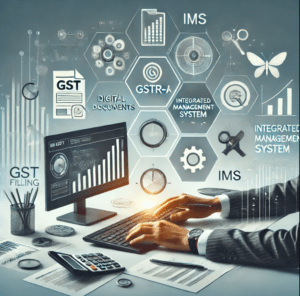The Goods and Services Tax (GST) system in India continues to evolve, bringing in new processes to simplify compliance for taxpayers. One of the key changes has been the introduction of the Invoice Matching System (IMS) and the streamlined usage of GSTR-1A, both of which play a crucial role in improving the accuracy of GSTR-3B filing. This article will explore how these updates can help businesses navigate GST filing more efficiently.
Understanding GSTR-1A and Its Role
GSTR-1A is a draft return that allows taxpayers to correct the information submitted in GSTR-1. Once the details of outward supplies are uploaded in GSTR-1, the data gets reflected in the recipients’ GSTR-2A. If there are any discrepancies, the recipient can either accept or reject the changes through GSTR-1A, thereby updating the supplier’s GSTR-1. This process ensures that both the supplier and recipient are on the same page regarding the transactions.
The reconciliation process enabled by GSTR-1A is crucial for maintaining accurate records and avoiding mismatches that may arise during the final submission of GSTR-3B.
What is the Invoice Matching System (IMS)?
The Invoice Matching System (IMS) is a significant feature designed to ensure the seamless matching of input tax credits (ITC) between suppliers and buyers. The IMS uses data from GSTR-1 and GSTR-2A to match the invoices declared by both parties. This automated system checks whether the details submitted by suppliers align with those of their buyers. It plays a pivotal role in minimizing discrepancies and preventing fraudulent claims of ITC.
By integrating IMS into the GST framework, the government aims to reduce the burden of manual reconciliation and errors during GSTR-3B filing, making the entire process more efficient.

How IMS and GSTR-1A Enhance GSTR-3B Filing
1. Accurate Input Tax Credit (ITC) Claims
One of the main challenges for businesses is ensuring that their ITC claims are accurate. GSTR-1A allows businesses to correct any errors in their outward supply data, ensuring that the recipient’s ITC claims in GSTR-2A are correct. The IMS further ensures that only matched invoices are considered, reducing the chances of incorrect or fraudulent claims. This accuracy is crucial for seamless GSTR-3B submission, where ITC plays a vital role.
2. Reducing Compliance Errors
With the automatic data matching of IMS and the ability to revise information using GSTR-1A, businesses are less likely to face compliance issues. This reduces the likelihood of penalties or delays in GSTR-3B filing due to mismatches in transaction details.
3. Time-Saving Automation
The IMS significantly reduces the manual effort required for invoice reconciliation. Since the system automatically matches invoices between the buyer and the supplier, businesses can focus on other aspects of their operations instead of spending time resolving mismatches.
4. Ensuring Smooth GSTR-3B Submission
When GSTR-1 and GSTR-2A details are in harmony, filing GSTR-3B becomes much smoother. By the time businesses get to this stage, most discrepancies have already been addressed through the GSTR-1A process and IMS checks, resulting in faster and more accurate submissions.
Conclusion
The introduction of GSTR-1A and the Invoice Matching System (IMS) has been a game-changer in the GST framework. By enabling better reconciliation of invoices and reducing the chances of errors, these tools greatly enhance the accuracy of GSTR-3B filing. As GST compliance becomes more automated and streamlined, businesses can look forward to a smoother, more efficient process, allowing them to focus on growth and profitability without getting bogged down by complex tax filing procedures.
For businesses, staying updated on these changes and ensuring timely corrections in GSTR-1A while using IMS effectively can lead to significant time and cost savings during GST filing.
